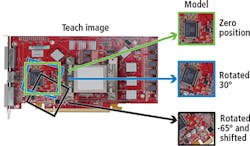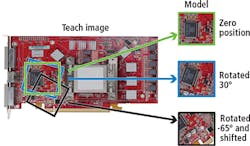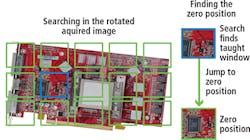Image processing software: Pattern recognition software targets pose estimation
Pattern matching tools are used in many machine vision systems to locate objects of interest within an image. During a teaching stage, the system is first presented with a known good template image from which information is extracted. Then, during the matching phase, information from an unknown image is extracted and this data compared with that extracted from the template image. Here, the success of such pattern matching techniques depends on how well the extracted data from the template and unknown image matches under a variety of geometrical transformations such as rotation, translation and scaling size and factors such as illumination variability.
Today, a number of different methods exist to perform pattern matching including normalized grey scale correlation and geometric pattern matching (see "Pattern-matching imaging software overcomes variances," Vision Systems Design, May 1999; http://bit.ly/1eMLA1N). Tools such CVB ShapeFinder from Stemmer Imaging (Puchheim, Germany; www.stemmerimaging.com) use the latter approach by creating a teaching model based on the extraction of gradient characteristics extracted using the Hough transformation. Other approaches also exist. In the company's CVB Manto pattern recognition software, for example, texture, color and geometric characteristics are extracted from a template image and applied to a support vector machine that is then used to classify unknown images.
While useful, pick and place robotics applications require that objects must be recognized from a number of different positions. The direct impact on the teaching phase is that a given pattern must be taught in all of its variable positions so that it can be reliably detected in the acquired image. As a result, Stemmer Imaging has developed its CVB Polimago software package that has been designed specifically for recognition of objects in various poses.
The operating principle of CVB Polimago is based on the training, data extraction and matching operations common to every pattern matching tool. The first step is to extract characteristics from a template (shown in green on the figure on page 9) that are then saved in a model.
Artificial views of the template are then created to reproduce various positions of the scene that may be encountered. For illustrative purposes, rotated and translated images are shown. As a result, the algorithm learns the variability of these images and can thus recognize the teaching image in many different views. For each transformation, the reverse transformation can then be used to recover the zero position of the teaching image. This iterative process generates random teaching images that are saved in the model along with their transformations. Although the number of teaching images regularly reaches thousands, they are automatically generated and no user interaction is required.
To determine the recognition rate and execution speed of CVB Polimago, the search results were compared to the results of the CVB ShapeFinder geometric pattern matching tool. Using a number of arbitrary and affine transformations, Stemmer Imaging demonstrated that both processes are capable of capturing the orientation of a previously taught component with an accuracy of 0.1°.
By using this simulated teaching method, CVB Polimago is capable of learning various positions of an object making the software suitable for tasks that require pose estimation and tracking of objects. CVB Polimago can also be used with Stemmer Imaging's CVB Minos for optical character recognition and CVB Manto.



